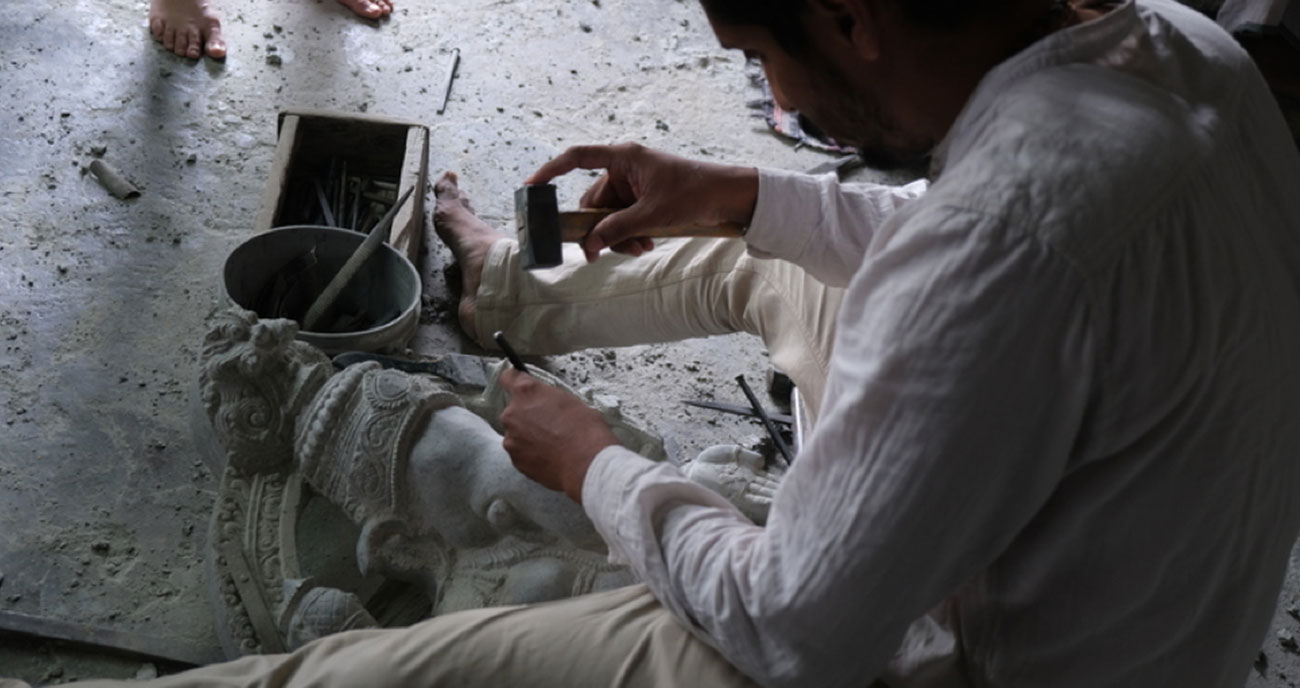
24 Apr Feet! Reverence and Revelation
In India, I noticed how much feet are revered.
One touches the feet of their guru or elder to symbolically show deep respect. There is much to learn from the person who has trekked along the path of knowledge. Their feet are symbols of grounding, of steady footing, so to speak.

And simple stone carvings of feet are created in homage as idols to worship.
Similarly, in everyday life in India, you show respect for others by removing your shoes before entering a house, a temple, or even any sort of shop – which sometimes surprised me.
On my recent trip to India, we visited a stone carver’s workshop. All the workers were barefoot as they chipped away at the stone and, to be respectful, we removed our shoes before coming inside to get a closer look at their craft. We stepped and stood with the workers amongst the shards of stone, layers of dust, and sharp metal tools strewn about. My Western mind, shaped by OSHA standards of workplace safety, had to suspend all concern and simply tread lightly and intentionally.
 There is something poetic, natural, and intimate about everyone taking off their shoes in a public place.
There is something poetic, natural, and intimate about everyone taking off their shoes in a public place.
Shedding the coverings of society and feeling the ground beneath our feet, steady footing is much more accessible.
This simple act forces us to be more present and aware of our surroundings.
Conversely, in the US, I’m noticing how much we hide and cover our feet. We adorn them with elaborate pedicures yet we scorn them. Going barefoot is seen as dirty and very informal. Signs are often posted to remind us it’s not allowed to go barefoot in stores or public places. And so we shroud our feet in high-tech “supportive” cushions or elevate them in awkward angles for high fashion or protect them with thick soles and steel toes.
We rarely use our feet to their full range of mobility. We walk on smoothed out, level sidewalks and floors in the aforementioned shoes. If there is a crack in a sidewalk or a bump in the carpet we post “caution” tape or other signage to alert us to pay attention to what might trip us up, blaming the anomalous terrain and not our lack of mindfulness as an issue.
I contend that we lose connection to the world around us in large part by how much our daily life does not take advantage of all the features of our bare feet.
Our general population and culture relies on cars, elevators, and escalators versus walking. And we sit… a lot.
There is nothing at all wrong with any of this and you won’t find me walking barefoot around town but there are consequences to our customs – including, but not limited to, the fact that we as a society tend to have a higher percentage of foot issues, knee issues, hip and back issues than other cultures.
But in yoga, we’ve adopted some of the cultural norms from India regarding feet.
We remove our shoes before stepping into the studio room.
We are barefoot during our class, and challenge the level terrain by shifting our bodies into unusual angles giving our toes a chance to spread and our ankles a chance to realize their full range of motion.
We use our feet in every pose – whether standing or sitting or even in inversions.
 We gaze at our toes and fully engage our feet.
We gaze at our toes and fully engage our feet.
There is a lot to learn in yoga classes about exactly where to put our feet, how to use our feet, and what is the function of a particular position of our feet; but often there isn’t enough time to really go into the details. And if we go to a variety of classes, we’ll hear different and often conflicting alignment cues depending on the teacher and the style of yoga. I’ve heard it all. It can be confusing.
But if we are to truly make our yoga practice our own, we need to learn how to work with our own feet as they are – as fabulous and flawed as they may be – and learn how they relate to the rest of our body and how this affects our state of mind. This is yoga after all.
So, in your next class pay attention to your feet. Feel them on the floor or sticky mat and begin to pay more attention to what they have to share with you. And go barefoot at home as often as possible.
Let’s consider our own feet our gurus!
If as a Western society we aren’t worshipping others’ feet, I think we can at least learn how to revere and honor our own. 🙂
It can be a revelation how much information and knowledge our own feet convey to us!
Make the most out of practicing yoga barefoot with my Fit Feet course.




Bill Hoke
Posted at 06:31h, 05 DecemberMary Beth,
I enjoyed this blog, and as I mentioned in class today, it resonates with running themes I’ve enjoyed and applied. The books that inspired me were Born To Run and The Story of The Human Body. The latter book, by Daniel Lieberman, makes some of the same points you make in your blog about the things we do that we didn’t evolve doing, including sitting a lot. The Indian rituals you described added an interesting cultural angle. Good stuff to notice, think about, and live by. Thanks!
Bill
Mary Beth Ray
Posted at 17:40h, 05 DecemberHi Bill – so glad you enjoyed this and thanks for the tip on The Story of the Human Body book. I’m not a runner but I know I will enjoy reading this! All my best, mb